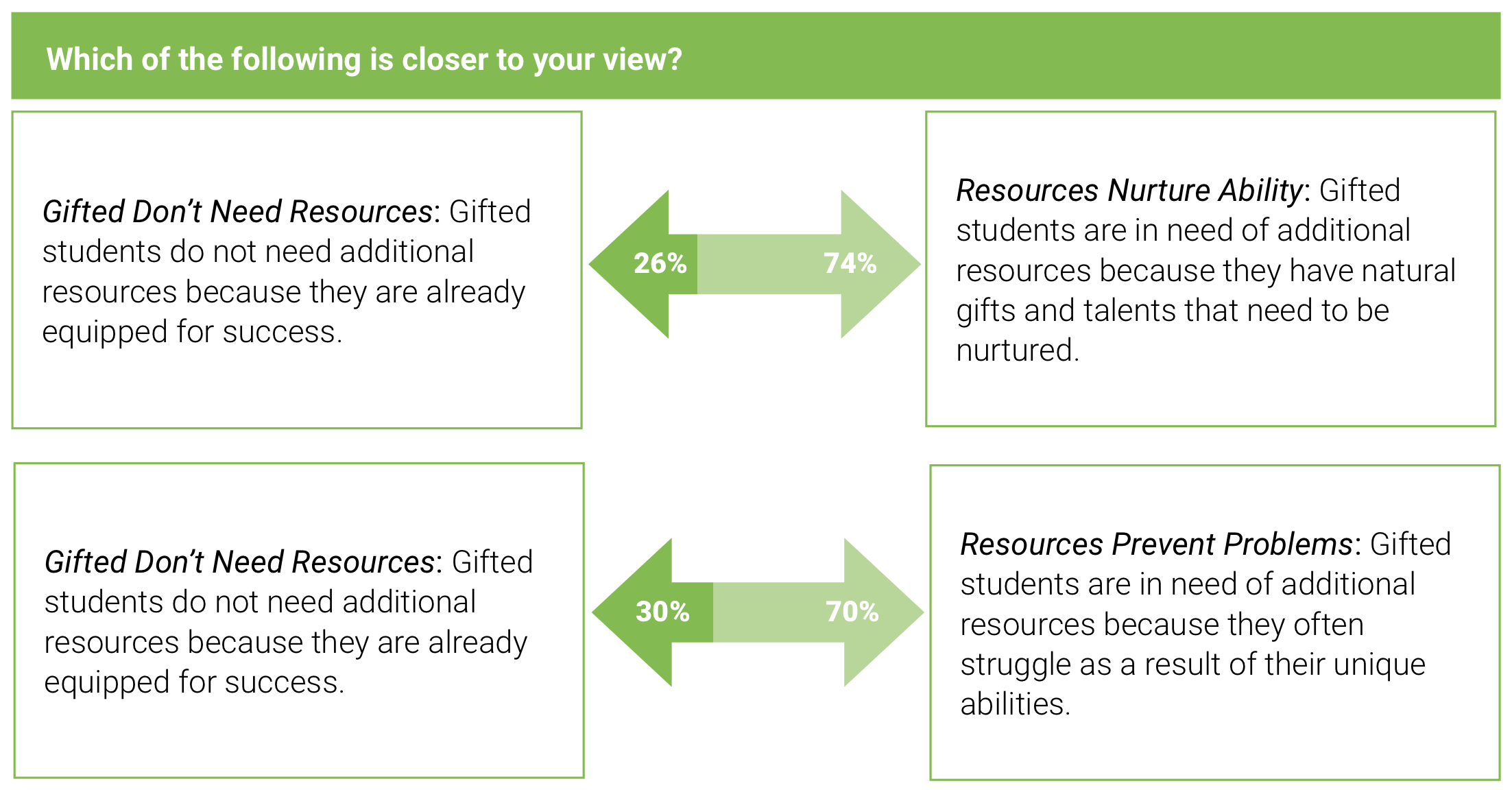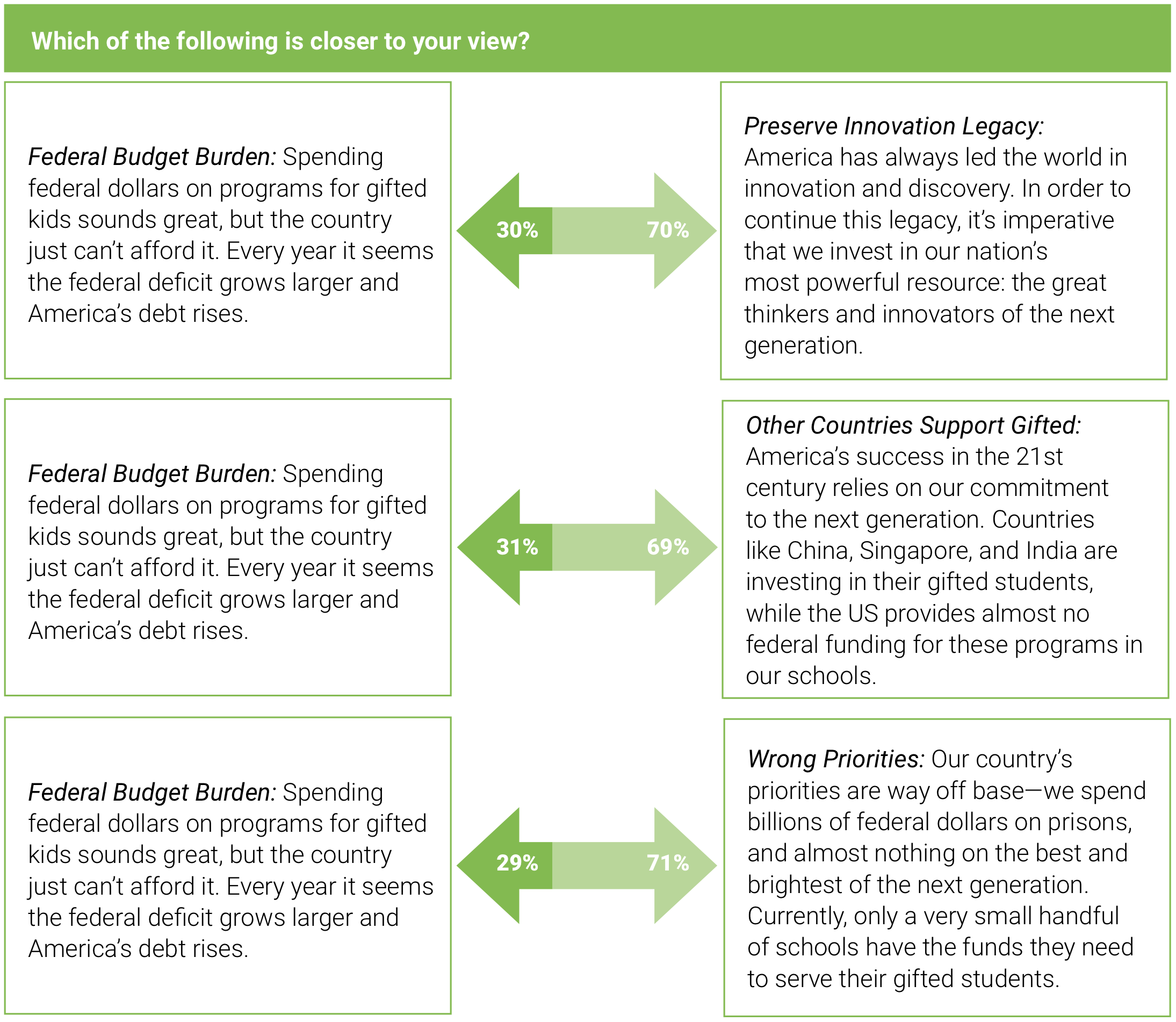For or Against: Testing Contrasting Messages
Advocacy arguments rarely occur in a void– messages advocating for a cause must be persuasive enough to prevail when countered by arguments against the cause. To assess the impact of opposing advocacy messages, the IEA-P gauged public response when presented with common arguments for and against gifted education.
Common Opposition Messages
Three common arguments against gifted education were presented to poll respondents: (1) Gifted Don’t Need Resources, claiming that gifted students will be fine without special programs; (2) Siphoning Resources, suggesting that gifted education programs will take money away from other students; and (3) Federal Budget Burden, positing that funding gifted education would further strain the federal budget deficit. Each of these opposition arguments was juxtaposed with two or more favorable arguments supporting gifted education. In each case, respondents read the opposition argument and then one or two favorable arguments; after reading each argument they were asked to select the position they agreed with more (Table 6.1).
Gifted Don’t Need Resources. All IEA-P respondents were presented with contrasting positions asking whether gifted students require more educational resources or whether they would be “just fine” even in the absence of special programs. The opposition message, Gifted Don’t Need Resources, argued that gifted students need no special services because they already have advanced skills. This argument was paired with two arguments favorable to gifted education arguments: Resources Nurture Ability, which countered that additional resources are necessary for gifted students to achieve their full potential; and Resources Prevent Problems, which claimed that gifted students need resources because they struggle in their absence. Respondent choices are summarized in Table 6.2.
Questions posed earlier in the poll already established that IEA-P respondents believe gifted students should receive the specialized services they require (see Chapter 5). Answers to the Gifted Don’t Need Resources argument continued this trend: Respondents were much more likely to support the arguments in support of gifted education (Figure 6.1). When contrasted against the argument that gifted students are already equipped for success, 74% agreed instead that gifted students have a right to fulfill their potential and 70% agreed instead that gifted students would struggle if they did not have special programs. Interestingly, variations of each of these two favorable messages failed to convince a large proportion of respondents when they were presented on their own. In this case at least, messages which were modestly effective on their own were more compelling than an opposition message that relatively few respondents believed.
Education Influencers. Although Opinion Elites and Parents were more likely to agree with both favorable arguments than with the Gifted Don’t Need Resources counterargument, the rate of agreement was higher for the Resources Fulfill Potential argument. Parent agreement with Resources Fulfill Potential was particularly high, with 80% choosing that message over Gifted Don’t Need Resources.
Racial/Ethnic Groups. Over 60% of each analysis group agreed with the favorable messages; however, Hispanics were somewhat less likely to agree than Black or White respondents. Black respondents were more likely than Hispanics to select Resources Fulfill Potential (77% Black and 68% Hispanic respondents).
Messages in Opposition to Gifted Education and Contrasting Favorable Messages
|
Opposition |
Favorable |
|
Gifted Don’t Need Resources . Gifted students do not need additional resources because they are already equipped for success. |
a) Resources Nurture Ability. Gifted students are in need of additional resources because they have natural gifts and talents that need to be nurtured. |
|
b) Resources Prevent Problems . Gifted students are in need of additional resources because they often struggle as a result of their unique abilities. |
|
|
Siphoning Resources . Devoting more resources to gifted students will take resources away from other students who may need those resources more. |
a) Aspiration & Need . Investing in gifted children—who often struggle because of their unique gifts —is one of the best investments we can make in our communities and economic future. |
|
b) Disagreeable Choices . When it comes to our children, we shouldn’t be forced to decide between one group and another—all their needs should be met. |
|
|
a) Preserve Innovation Legacy . America has always led the world in innovation and discovery. In order to continue this legacy, it’s imperative that we invest in our nation’s most powerful resource: the great thinkers and innovators of the next generation. |
|
|
Federal Budget Burden . Spending federal dollars on programs for gifted kids sounds great, but the country just can’t afford it. Every year it seems the federal deficit grows larger and America’s debt rises. |
b) Other Countries Support Gifted . America’s success in the 21 st century relies on our commitment to the next generation. Countries like China, Singapore, and India are investing in their gifted students, while the US provides almost no federal funding for these programs in our schools. |
|
c) Wrong Priorities . Our country’s priorities are way off base — we spend billions of federal dollars on prisons, and almost nothing on the best and brightest of the next generation. Currently, only a very small handful of schools have the funds they need to serve their gifted students. |
Percentage Who Agree with Favorable Messages When Contrasted with the Opposition Message Gifted Don’t Need Resources (Q40-41)

Notes. <$50 = Income under $50,000/year, $50k+ = Income $50,000 and up, OE = Opinion Elite, Hisp. = Hispanics, Par = Parents. At the 95% confidence level the standard error of measure for the entire sample is ±2.51%. It is ±6.21% among Opinion Elites, ±3.73% among Parents, ±6.03% among Blacks, ±5.81% among Hispanics, and ±3.33 among Whites. Race/Ethnicity does not include respondents who selected more than one race. Race/Ethnicity x Income does not include respondents who selected “Prefer Not to Indicate.”
Responses also differed according to income group; higher-income respondents were more likely to agree with the Resources Prevent Problems argument than their lower-income counterparts. The greatest income disparity was among Black respondents, where 69% of lower-income Blacks agreed that resources prevent problems, compared with 80% of higher income Blacks.
Disagreeable Choices: When it comes to our children, we shouldn’t be forced to decide between one group and another— all their needs should be met.
Gifted Education Siphons Resources Away from Others. The second juxtaposition placed the opposition argument that gifted education takes resources away from other students, Siphoning Resources, against two favorable messages (Figure 6.2, Table 6.3). [12] The first favorable message, Aspiration & Need, began and ended with statements about investing in national well-being, with the mention of gifted students’ needs sandwiched in the middle. The other favorable message, Disagreeable Choices, was different from other messages in the poll because it was generic, not specific to gifted education. This argument suggested that people should not have to choose between the needs of different groups of children—it was, in effect, an argument against limited education budgets.
Disagreeable Choices . The public communicated their frustration that meeting the needs of one group of students required sacrificing the needs of another group through their choice between Siphoning Resources and Disagreeable Choices. Eight in ten agreed with the message in Disagreeable Choices, that all students’ needs should be met. This was the highest rate of agreement for any advocacy message tested at any point in the poll and reinforces the general concern over public education reflected in benchmark items (see Chapter 2). Although the message itself presents no solution to the problem of difficult choices, it does reveal the public’s attitude towards the constant conversation about trade-offs in education. In an ideal world, they would have schools receive all the resources they need– including resources for gifted students.
Education Influencers. Parent’s responses paralleled the other analysis subgroups, with 79% agreeing with the Disagreeable Choices message over Siphoning Resources. Opinion Elites were less likely than other subgroups to select Disagreeable Choices (69).

Figure 6.1. Percentage of responses to messages for and against gifted education based on the Gifted Don’t Need Resources argument.

Figure 6.2. Percentage of responses to message favorable to gifted education and opposing based on the Siphoning Funds argument.
Percentage of Respondents Who Agree with a Favorable Message when Contrasted with the Opposition Message Siphoning Resources (Q44-45)

Notes. Par = Parents. Aspiration & Need = Split Sample X, Desirable Choices = Split Sample Y. Weighted n provided for Split Sample X. For weighted n for Split Sample Y and all subgroups, along with standard error of measure see Appendix B, Table B3. Race/Ethnicity does not include respondents who selected more than one race. Race/Ethnicity x Income does not include respondents who selected “Prefer Not to Indicate.”
Racial/Ethnic Groups. Only small differences were observed among the three racial/ethnic analysis groups; three out of four respondents agreed with the Disagreeable Choices across racial/ethnic groups. Support was especially strong among lower- income Hispanic (85%) and higher-income White respondents (84%). Far fewer higher-income Black respondents agreed with this position (69%).
Aspiration & Need . While the vast majority of respondents agree that gifted students need resources, they were ambivalent about spending on gifted students when faced with the prospect that the money would take resources from others. More than half of the sample (57%) agreed with Aspiration & Need over Siphoning Resources, but the rate of agreement was lower than for any other message.
Education Influencers. Opinion Elites responded in similar proportions to Disagreeable Choices (69% Agree) and to Aspiration & Need (66% Agree). As a result, even though they were less likely than other groups to agree with Disagreeable Choices, they were more likely than other groups to agree with Aspiration & Need. Responses from Parents paralleled the trends among other groups. Over half of the Parents who responded to the Aspiration & Need message agreed with it and not with the Siphoning Funds messages, but more agreed with Disagreeable Choices.
Racial/Ethnic Groups. Black respondents were less likely than other racial/ethnic groups to agree with the tenet in Aspiration & Need that gifted education is one of the best investments in the future: 48% of Black, 58% of White, and 54% of Hispanic respondents agreed with the Aspiration & Need message. Lower-income White and Hispanic respondents were equally likely to agree with either Siphoning Resources or Aspiration & Need (52% and 50% agreed with Aspiration & Need, respectively), while lower-income Blacks were less likely to agree with Aspiration & Need (41% Agree).
Federal Budget Burden . Responses to the Disagreeable Choices question again revealed the public’s overwhelming desire to provide adequate resources to all children in public schools. That desire appeared again in the third forced choice question, where the opposition message Federal Budget Burden was positioned against three pro- gifted messages: (a) Preserve Innovation Legacy, that investing in gifted students is an investment in America’s leadership in innovation and discovery; (b) Other Countries Support Gifted, that investing in gifted students at levels similar to international competitors is essential for economic prosperity; and (c) Wrong Priorities, that funding choices should prioritize proactive investments such as gifted education over remediation in prisons. [13]
Percentage of Respondents Who Agree with Favorable Message when Contrasted with Opposition Message Federal Budget Burden (Q46-48)

Notes. B3. Race/Ethnicity does not include respondents who selected more than one race. Race/Ethnicity x Income does not include respondents who selected “Prefer Not to Indicate.”
The rate of agreement for these messages is presented in Table 6.4. Consistent with the other forced-choice questions, the public was more likely to agree with positions in favor of fully funding education, including gifted education. The three messages favorable to gifted education were equally effective when contrasted with the position that funding gifted education would create a burden on the federal budget: 70% agreed with Preserve Innovation Legacy, 69% with Other Countries Support Gifted, and 71% with Wrong Priorities (Figure 6.3). The Other Countries Support Gifted and Wrong Priorities messages were both very convincing when positioned against counterarguments. Perhaps more surprisingly, the Preserve Innovation Legacy message, which was similar to two ineffective stand–alone messages, was effective in countering the Federal Budget Burden argument.
Education Influencers. Parents and Opinion Elites were unpersuaded by the Federal Budget Burden message. Each group responded in favor of the all the pro-gifted messages, with around 70% of each group agreeing with each message.
Racial/Ethnic Groups. In general, respondent choices were similar across racial/ethnic demographics. Between 60-82% of each racial/ethnic group selected a pro-gifted message over the Federal Budget Burden argument, regardless of message content.
When juxtaposed, messages advocating for gifted students were always more persuasive than opposition messages.

Figure 6.3. Percentage of responses to messages favorable to and opposing gifted education based on the Federal Budget Burden argument.
Synopsis
When juxtaposed, messages advocating for gifted students were always more persuasive than opposition messages. Without additional testing, it is hard to tell whether this is because the favorable messages were effective or because the opposing messages were not.
- Throughout the IEA-P, respondents indicated support for providing gifted students with the resources they need. This support was reinforced again in the public’s rejection of the Gifted Don’t Need Resources message which claimed that gifted students do not need additional resources because they are already equipped for success.
- When the opposition message Siphoning Funds was paired against a favorable message promoting gifted education as an investment in the future, 57% of IEA-P respondents selected the favorable message which blended gifted students needs with an aspiration for national well-being.
- When balancing the tradeoff between an increase in the Federal Budget Burden or providing resources for gifted students, the public consistently favored providing resources for gifted students.
- Of the three opposition messages, Siphoning Funds was the most likely to draw support away from gifted education. Again, this reinforces the public’s distaste for funding trade-offs in public education.
References
Jack Kent Cooke Foundation. What is the excellence gap. (n.d.). Retrieved from https://www.jkcf.org/our-research/what-is-the-excellence-gap/

